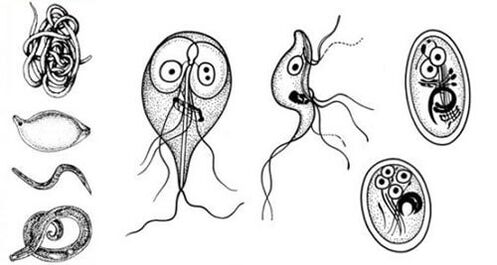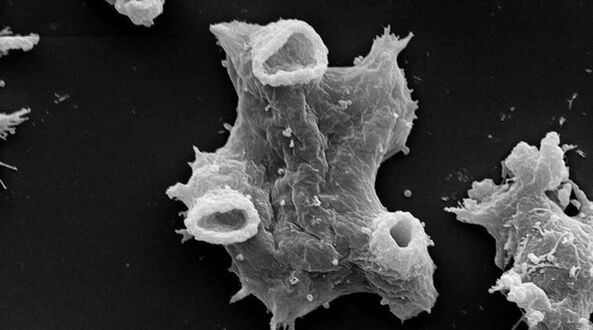It is customary to refer to parasitic protozoan microorganisms as those parasites that are constantly in the human body and feed on its "juices". They have nothing to do with worms, but some single-celled parasites can grow to large sizes.

They are completely independent organisms, although they have lost the digestive vacuole, caused by their lifestyle.
parasite classes
Representatives of various bodies can be classified as follows:
- sarcode- negleria and amoeba.
- spores- Toxoplasma Plasmodium.
- ciliates‒ balantidium
- scourges- Leishmania, Trichomonas, Trypanosomes and Giardia.
These organisms are one of the first simple organisms that appeared on the planet. Its elementary structure and work functions can cause the development of fatal diseases. The list contains common representatives of protozoan parasites, but there are many more.
impact on the body
Although these parasites are called protozoa, they have a very negative effect on the human body, causing serious illness.
sarcode
dysenteric amoeba (Coinhistolytic).The parasite is more common in hot countries. One feature is the absence of skeletal and shell formations. She has legs for locomotion. It can form cysts in the human body.
It often causes amoebiasis when the intestinal wall is affected. A person has loose bloody stools. Diagnosing such an amoeba is quite difficult. She is a very dangerous parasite.
Negleria Fowler.Man is the intermediate host. The location of the parasite is usually the brain.
It causes amoebic meningoencephalitis, which is often fatal.
scourges
Trichomonas (trichmonasvaginal).The disease occurs in men with almost no symptoms, only in the form of transport. In women, it manifests itself with pronounced signs of inflammation: profuse discharge with an unpleasant odor, itching and pain in the lower abdomen.
This simplest parasite, as a rule, is transmitted sexually, but it also happens to be through domestic contact. Infected women can infect their baby during delivery.
Giardia.These microorganisms parasitize in the gastrointestinal tract. The impact on the body consists of cystic transport for many years, but the disease proceeds mildly. It rarely becomes chronic. By the way, they are not afraid of toxic substances and ultraviolet radiation.
spores
Leishmania (Leishaniaspp).This species is located in almost all human organs and ends up destroying them. It causes a serious disease - visceral leishmaniasis. In its habitat, an open ulcer forms, which constantly rots. It is difficult to treat and often requires surgery.
Plasmodium malaria.It is located in blood plasma, erythrocytes and liver cells. What's worse is that these simple organisms destroy red blood cells. It leads to tropical and multi-day malaria. It can seriously damage the kidneys and destroy the nervous system.
Toxoplasm.It affects the lymph nodes and small intestine. Toxoplasmosis often develops, which is very dangerous for pregnant women. In the early stage of infection, it mimics a viral infection.
ciliates
Intestinal balantidia (balantidiumcoli).It usually affects the large intestine, in particular the cecum. This is a rather large single-celled organism that is easily introduced into the blood.
They don't do much harm to the body, but ulcers can occur in the intestines.
Symptoms and diseases caused by protozoan parasites
Currently, several pathogens have been discovered that cause the following diseases:
- Giardiasis.
- Malaria.
- Leishmaniasis.
- Trichomoniasis.
- Cryptosporidiosis.
- Balantidiasis.
dysenteric amoeba
Infection occurs through food and household items.
Symptoms that appear with a mild course of the disease:
- Flatulence.
- Cramping pains in the abdomen.
- Constipation is replaced by diarrhea.
The average severity of the course of the disease:
- The symptomatology increases within 10 days.
- There is weakness and loss of appetite.
- Bloody mucous stools.
- Abundant feces.
When the disease becomes chronic, the weight drops dramatically.
Pathologies caused by this parasite:
- Peritonitis.
- Amoebic appendicitis.
- Dysentery.
- Abscesses of the lungs and liver.
- Extremely rare amoebic hepatitis and brain abscess.
- Cutaneous amoebiasis with development of ulcers and erosions.
With an extremely rapid course of the disease, even a fatal outcome is possible in weakened people.
Naegleria fowleri (Naegleria fowleri)

You can get infected with this parasite by swimming in a pond as well as through the air.
The disease always begins with the manifestation of acute symptoms:
- Loss of smell and taste.
- Headaches and weakness.
- Nausea and the urge to vomit.
- Loss of coordination of movements.
- Pulmonary edema may develop.
- Hallucinations and convulsions.
It is very difficult to diagnose the disease, so it often ends with the death of the patient.
Negleria causes the following pathologies:
- Amoebic meningoencephalitis.
- Negleriasis.
- Destroys the brain.
- A person often goes into a coma.
The infection is often fatal.
lamblia
Diseases occur without pronounced symptoms. The infection is transmitted with unwashed fruit and through dirty hands.
Typical symptoms:
- Increased salivation.
- Discomfort in the abdomen.
- Loss of appetite and nausea.
Sometimes there are green stools with foam and a pungent odor.
Diseases caused: giardiasis and various intestinal disorders.
Leishmania
The infestation is caused by mosquitoes.
Has severe symptoms:
- Enlarged spleen and liver.
- High temperature rise.
- feverish conditions.
- Weakness and pallor of the skin.
- Bleeding in the skin.
- Problem with cardiac activity.
- Anemia and severe weight loss.
Sometimes edema and pneumonia can come together.
This parasite leads to cachexia, decreased muscle tone, impotence and heart failure.
trichomonas
Infection occurs with promiscuity and hygiene items. Symptoms are usually absent but occasionally appear.
For men:
Discomfort when urinating.
- There is blood in the semen.
- Whitish discharge.
Among women:inflammation of the cervix and vagina.
The infection is very dangerous for pregnant women as it can cause premature birth.
Plasmodium Malaria
Mosquito bites lead to infection.
Plasmodium vivax.Symptoms depend on the stage of the disease:
- Chills up to 3 hours - muscle and joint pain, liver pain.
- Fever for about 12 hours - temperature up to 40 degrees, decreased pressure, shortness of breath and tachycardia.
- Stage of heavy sweating - a sharp decrease in temperature with the release of sweat, muscle weakness and hypotension.
Three-day malaria may develop and spontaneous recovery may occur. There may be an enlarged spleen, anemia, and sometimes jaundice.
Plasmodium malaria.There are feverish attacks in the morning and at night. In addition, there are signs of three-day malaria. It can cause the development of nephrotic syndrome, which is difficult to treat.
Plasmodium oval.Fever attacks only occur at night. The disease proceeds quite easily, but the liver may enlarge slightly.
toxoplasma
The forms of infection are quite extensive. You can get infected from undercooked meat, dirty products, blood transfusions, and cuts on your skin. By the way, the infection of a pregnant woman is often transmitted to the fetus.
In the presence of an acute form of the disease, the following symptoms appear:
- Obvious enlargement of the liver and spleen.
- Signs of jaundice.
- Rash.
- Typical symptoms of meningitis and encephalitis.
- Lymph nodes are enlarged.
In the chronic form:
- High temperature for a long time.
- Pain in muscles and bones.
- In women, the menstrual cycle is interrupted.
- There is a headache and irritability.
Also, there can be problems with the thyroid gland and adrenal insufficiency.
Infection with parasites of this class threatens the occurrence of many diseases:
- oligophrenia.
- Toxoplasmosis.
- epileptic seizures.
- Inflammation in the retina.
- hepatolienal syndrome.
Rarely, but still, sclerosis of the lymph nodes occurs.
intestinal balantidia
You can catch the parasite through unboiled water, through dirty hands and through fruit.
Signs of infection:
- Prolonged diarrhea, with pus and blood.
- Abdominal pain syndrome.
Balantidia leads to the development of peritonitis, organ abscesses and perforation of the intestinal walls.
Conclusion
Protozoan infection is very similar to virus infection. By definition, they are not considered worms, although they cause great harm to human health.
Infection with protozoan parasites can lead to death, so when typical symptoms appear, you should seek medical help immediately. Self-medication is strictly prohibited.






































